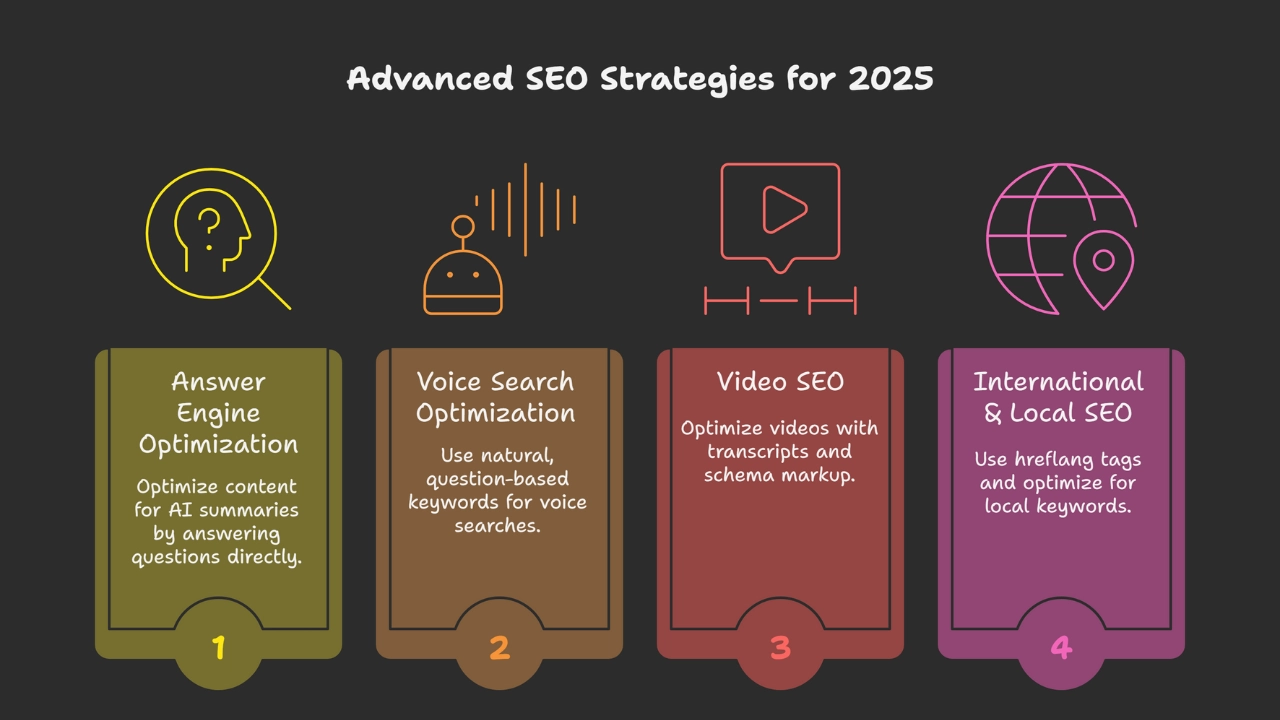You may have heard the buzz: “SEO is dead.”
It isn’t. What’s actually occurring is evolution. In 2025, SEO isn’t about getting onto page one anymore—it’s about appearing where your buyers are: AI Overviews, answer engines, voice assistants, and video search results.
Consider the following: Google is redefining search with AI-generated summaries, Alexa and Siri are answering questions in real time, and TikTok-type product videos are appearing natively in search carousels. If your company doesn’t evolve, you will be rendered invisible.
The better news? These changes don’t destroy SEO—they open it up. Old standbys such as site speed, product page optimization, and long-tail keywords remain important. But added on top are new possibilities such as Answer Engine Optimization (AEO), Voice Search Optimization (VSO), and shoppable video SEO.
And here’s why you can’t afford to ignore it: based on studies, 40% of all e-commerce traffic is driven by search engines, and those stores that spend money on SEO enjoy as much as 2x higher conversion rates than those that only depend on ads. This is not just about rankings—it’s about real sales, increased margins, and creating a brand that customers trust.
This step-by-step guide will dissect all there is to know about E-commerce SEO in 2025. If you’re a startup store or an established brand manager, you’ll have a plan you can implement.
Core Elements of a Modern E-commerce SEO Strategy
E-commerce SEO at its most basic level is about getting your products seen by individuals who are actively searching with purchasing intent. Consider queries such as:
- “Buy wireless earbuds online”
- “Best vegan skincare products”
- “Affordable laptop bags free shipping”
These aren’t idle queries; they’re indications that a person is about to buy—or is nearly ready to buy. Leveraging that intent is what differentiates top-performing stores from those that get lost in the search results.
To achieve that well in 2025, your foundation needs to be on five pillars:
1. Site Structure & Navigation
Picture yourself entering a physical store where items are dumped haphazardly. That’s what bad site structure is like for both customers and search engines. Your site needs to adhere to a neat hierarchy—Home > Category > Subcategory > Product—and employ breadcrumbs so search engines can recognize page-to-page relationships.
A sensible structure not only aids crawlability but also boosts users’ trust. Customers shouldn’t be more than three clicks away from any item.
2. Technical SEO
This is the foundation of your store. A slow or insecure site is like a store with busted lights and locked doors. In 2025, speed, mobile-first design, and structured data aren’t “nice to have”—they’re required.
Google favors mobile functionality, and purchasers anticipate load times of less than 3 seconds. Secure hosting (HTTPS) is not merely an SEO consideration; it comforts customers at checkout. Structured data, particularly Product and Offer schema, causes your products to become eligible for rich snippets with price, inventory, and reviews directly displayed in search results.
3. On-Page SEO
Each product page must contain a distinct, keyword-laden title, a compelling meta description, and a robust product description. Far too many stores just reproduce manufacturer copy, producing duplicate content that poisons rankings. Instead, write copy describing why this product differs and responds to typical buyer inquiries.
4. User-Generated Content (UGC)
Customers trust fellow customers. Reviews, ratings, and Q&A pages not only establish credibility but also generate new, keyword-filled content that Google adores. Nearly 95% of consumers read reviews before buying, so ignoring user feedback costs you trust—and conversions. Featuring reviews is fuel for your SEO fire.
5. High-Quality Visuals
Images and video are at the heart of e-commerce. High-quality images minimize uncertainty for customers, and optimized file names, alt-text, and captions communicate relevance to search engines. Look to move beyond static images using short demo videos or 360° views—both of which increase engagement time, an important ranking signal.
Product Page SEO That Converts: Your Checklist
Your product pages aren’t about visibility alone; they’re where revenue meets search intent. Let’s dissect how to turn them into conversion machines.
Unique Titles and Descriptions
Generic headings aren’t going to work. Instead of “Men’s Shoes”, use a title like “Men’s Waterproof Hiking Boots | Brand X.” The more descriptive, the better. Individual product descriptions should promote benefits, answer questions, and tell a mini-narrative—assisting purchasers in visualizing how the product will fit into their lives..
High-Quality Images (with Alt Text)
Don’t depend on a single image. Utilize various pictures from various perspectives, lifestyle shots, and even close-up details. Include each picture with descriptive alt text, such as “Black leather handbag with silver clasp.” This enhances accessibility, ranks in image search, and comforts purchasers.
Structured Data and Rich Snippets
Structured data is how you speak to search engines in plain language. Implementing the Product, Offer, and Review schema makes your listings qualified for showing rich snippets with stars, prices, and availability. Testing demonstrates that Products with star ratings in search results have been shown to deliver a 35% higher CTR than identical listings without ratings
Customer Reviews and UGC
Each review is new content. They get long-tail searches to rank (“Is this bag durable?”) as well as comfort buyers. Bad reviews aren’t a death sentence—they make it real. What’s important is answering well.
Page Speed and Mobile UX
A slow site is a quiet killer. Google says that even a one-second delay can cut conversions by 20%. Test your site regularly with PageSpeed Insights, minify images, and optimize checkout to provide a frictionless mobile experience.
The Future: AEO, VSO & Advanced SEO Strategies for 2025
SEO remains important, but in 2025, you must add new strategies on top that accommodate AI-scarred results and new consumer search behaviors.

Answer Engine Optimization (AEO)
Google’s AI Summaries and other answer engines summarize content directly in search. To be featured, make your content answer explicit questions directly. Include FAQ sections, write conversational headlines, and mark them up with FAQ schema.
Voice Search Optimization (VSO)
With assistants such as Alexa and Siri, consumers are asking questions such as, “Where can I purchase green yoga mats for less than $50?” Voice searches are longer and more conversational. Optimize your page with natural, question-based long-tail keywords to get this traffic.
Video SEO
Video isn’t just for engagement—it’s now an SEO asset. Embed shoppable videos, add transcripts, and mark them up with VideoObject schema. With platforms like YouTube acting as search engines themselves, optimizing video can open new discovery channels.
International & Local SEO
If your store targets multiple regions, use hreflang tags to serve the right content to the right users. Even global brands can’t ignore local SEO: optimizing for local keywords and maintaining a strong Google Business Profile ensures you capture buyers searching nearby.
Tools, Analytics, and a Final Action Plan
The right tools keep your strategy sharp.
| Tool / Metric | Role |
|---|---|
| Ahrefs / Semrush | Keyword research, competitor insights, technical audits |
| Google Keyword Planner | Track search volume & trends |
| Google Search Console | Spot indexing errors, track performance |
| Analytics Dashboard | Monitor CTR, conversions, AOV by product |
| Moz Local / BrightLocal | Manage citations and local SEO |
Key E-commerce KPIs to track:
- Organic revenue growth per month/quarter
- Conversion rate per product category
- Average Order Value (AOV) from organic traffic
- Rich snippet click-throughs
- Crawl stats & mobile performance metrics
Final Action Plan
So, is SEO dead? Hardly. It has merely grown into something larger—incorporating AEO, VSO, and GEO in addition to conventional search strategies. In order to survive, your strategy must adapt too.
- Begin with Your Best-Sellers: Optimize your top 10 most performing product pages with descriptive titles, schema, reviews, and quick load times.
- Target Long-Tail Queries: Create clusters on 10–15 long-tail keywords, with a concentration on buyer intent.
- Optimize for Video SEO: Include videos with transcripts and schema on your best-selling products.
- Prepare for AI Summaries: Leverage FAQs and featured snippets to power Answer Engine Optimization.
- Develop Your Pillar Hub: Link this handbook to in-depth articles on Product Page SEO, Long-Tail Keywords, and SEO vs. E-commerce SEO to establish topical authority.
The early adapting stores will capture market share as others run to play catch-up. The door is wide open—you just need to take advantage of it.

